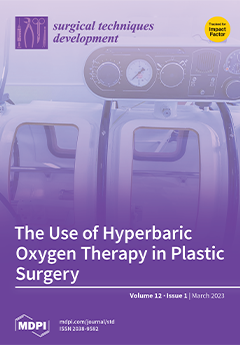Introduction: Hyperbaric oxygen therapy (HBOT) has been used over the past six decades to treat multiple conditions. This systematic review aims to identify and evaluate the clinical outcomes of hyperbaric oxygen therapy in the field of plastic, reconstructive, and aesthetic surgery, found in
[...] Read more.
Introduction: Hyperbaric oxygen therapy (HBOT) has been used over the past six decades to treat multiple conditions. This systematic review aims to identify and evaluate the clinical outcomes of hyperbaric oxygen therapy in the field of plastic, reconstructive, and aesthetic surgery, found in the literature from the year 2000 to the present.
Methods: A systematic review of the literature focused on the conceptual and methodological aspects of the PRISMA Declaration. The search for clinical trials focused on the results of hyperbaric therapy in plastic, reconstructive, and cosmetic surgery. The Newcastle–Ottawa scale suggested by the Cochrane manual was applied to each study. The study was carried out with a defined protocol and was registered in PROSPERO, with code CRD42022301261.
Results: From the 170 articles identified, 6 were selected. Five of them showed that hyperbaric oxygen therapy favored the reduction of the size of skin ulcers and increased the formation of granulation tissue (two trials;
p < 0.05), increased the partial pressure of transcutaneous oxygen in patients with free flaps (one trial;
p < 0.001), reduced perfusion in keloid scarring disorder (one trial;
p < 0.01), and accelerated both the fading of melanin pigmentation and the decrease in age spot size (one trial;
p < 0.05). The methodological quality was moderate in all cases because there was no blinding method reported. One study failed to find differences in flap survival, time to resolution of venous congestion, resolution of edema, and postoperative recovery period (
p > 0.05).
Conclusions: Hyperbaric oxygen therapy has been increasingly used in the field of plastic and reconstructive surgery, and has shown potential benefits in promoting wound healing, reducing the risk of infection, and improving the survival of tissues used in reconstructive procedures. Further research with more rigorous clinical trials is needed to fully understand the efficacy and optimal use of this therapy in the field of plastic and reconstructive surgery.
Full article




